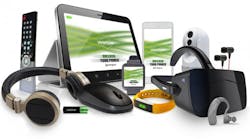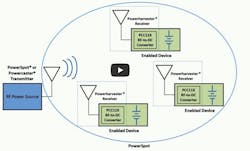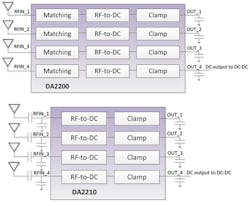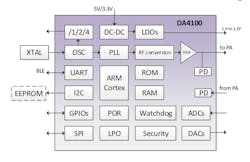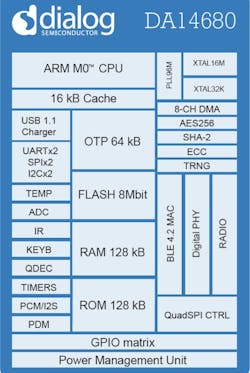Powercast Corp. and Energous Corp. have been certified by the FCC to provide power-over-distance wireless charging. Their wireless systems employ multiple technologies that include RF, analog, digital, power management, and software.
Powercast has its FCC-approved (FCC Part 15) and ISED-approved 3W PowerSpot transmitter that works in the far field (up to 80 feet) for over-the-air charging of multiple devices —no charging mats or direct line of sight needed. ISED is Canada’s Innovation, Science and Economic Development transmission regulations.
Energous is the developer of WattUp, with FCC certification of its first-generation mid- field transmitter that sends focused, RF-based power to devices at a distance. Its FCC certification for power-at-a-distance wireless charging is under Part 18 of the FCC's regulations.
Powercast Wireless Charger
The Powercast transmitter automatically charges enabled devices. The transmitter uses the 915-MHz Industrial, Scientific, and Medical (ISM) equipment band to send RF energy to a tiny Powercast receiver chip embedded in a device, which converts it to DC to directly power or recharge that device’s batteries.
Enabled devices charge when in range, but don’t need a direct line of sight to the PowerSpot (Fig. 1). Powercast expects up to 30 devices left in the zone on a countertop or desktop overnight can charge by morning, sharing the transmitter’s three-watt (EIRP) power output. (EIRP is effective, or equivalent, isotropic radiated power, the total power that would have to be radiated by a hypothetical isotropic antenna to give the same signal strength as the actual source in the direction of the antenna's strongest beam.) Charging rates vary with distance, type, and power consumption of a device:
- Power-hungry, heavily used devices like game controllers, smart watches, fitness bands, hearing aids, ear buds, or headphones charge best up to 2 feet away;
- Keyboards and mice up to 6 feet away;
- TV remotes and smart cards up to 10 feet away;
- Low-power devices like home automation sensors up to 80 feet away.
An illuminated LED indicates devices are charging and turns off when they’re done. Audible alerts indicate when devices move in and out of the charge zone.
The PowerSpot transmitter uses Direct Sequence Spread Spectrum (DSSS) modulation for power and Amplitude Shift Keying (ASK) modulation for data, and includes an integrated 6dBi directional antenna with a 70-deg. beam pattern.
Powercast offers a PowerSpot subassembly that consumer goods manufacturers can integrate into their own products. “PowerSpots” can charge multiple enabled devices around them. Powercast is in discussions with several manufacturers, and has inked deals with two household names, since releasing a wireless power development kit containing the PowerSpot subassembly.
Powercast’s COO/CTO Charles Greene, Ph.D, said, “others might be talking RF power possibilities, but we have consistently delivered far-field wireless power solutions that work, safely and responsibly, under FCC and other global standards providing power up to 80 feet.”
Developed with a partner, a PowerSpot transmitter adds the Qi inductive wireless charging standard adopted by many mobile phones, Greene said. “This combination would provide a best-of-both-worlds solution, operating within the FCC regulations that exist today, including RF over-the-air charging for multiple PowerSpot-enabled devices placed near the transmitter, and Qi proximity charging for power-hungry Qi-enabled mobile phones placed directly on the Qi charger on top of the PowerSpot transmitter.”
1. Here is an illustration of the PowerSpot system using Powercast transmitters and receivers.
The Powercast TX91501 Powercaster transmitter is specially designed to provide both power and data to end devices containing the Powercast P2110 or P1110 Powerharvester receivers. The TX91501 is housed in a durable plastic case with several mounting options. Operational power is provided to either of the two DC power connectors at 5V DC. The TX91501 includes a status LED to provide feedback on functional state. The TX91501 has a factory set, fixed power output, and no user-adjustable settings. The label indicates the effective power for which the device is configured, with 3 watts EIRP being the maximum. Once properly mounted, transmission is initiated by applying power to the TX91501.
P1110 Powerharvester Receiver
- Designed for battery charging and direct power applications.
- Harvesting range from 850-950MHz.
- Works with standard 50W
- Configurable overvoltage protection up to 4.2V.
- Connect directly to rechargeable batteries including Alkaline, Lithium Ion, and Ni-MH.
P2110B Powerharvester Receiver
- Designed for charging capacitors in battery-free devices, or energy cells with high input impedance.
- Provides intermittent/pulsed power output.
- Harvesting range from 850-950 MHz.
- Works with standard 50W
- Configurable, regulated output voltage up to 5.5V.
- Power management and control I/O for system optimization.
Energous Wireless Charger
Energous' WattUp mid-field transmitter underwent rigorous, multi-month testing to verify it met consumer safety and regulatory requirements. As the first Part 18 FCC-approved power-at-a-distance wireless charging transmitter, it paves the way for future wireless charging ubiquity for nearly any small electronic device, including smartphones, tablets, fitness trackers, smart watches, earbuds, wireless keyboards and mice, smart speakers, and more.
The company's WattUp mid-field transmitter can deliver power via RF energy to WattUp-enabled electronic devices at a distance of up to 3 feet. It can do both contact-based and non-contact-based wireless charging, as well as charge multiple devices at once. WattUp is scalable and automatically charges devices, as needed, until they are topped off. Energous achieves Wireless Charging 2.0, which is the ability to charge devices both at contact (including fast charging large battery devices such as smartphones and tablets), as well as power-at-a-distance. Similar to WiFi, the WattUp ecosystem ensures interoperability between receivers and transmitters, regardless of the manufacturer, making the entire ecosystem flexible and accessible for consumers and manufacturing partners.
"Older wireless charging technologies have received limited adoption over the past 15 years, and are confined to contact-based charging only,” says Stephen R. Rizzone, president and CEO of Energous. “The FCC certification of Energous' power-at-a-distance wireless charging transmitter is different. It opens up options, outside of just contact-based charging, to Wireless Charging 2.0: an ecosystem where devices can be charged both, via pad and at a distance. Untethered, wire-free charging—such as charging a fitness band even while wearing it—is exactly what consumers have been waiting for."
"Providing meaningful power-at-a-distance is a real game changer for wireless charging," adds Mark Tyndall, senior vice president corporate development and strategy, Dialog Semiconductor. "As the strategic partner and exclusive worldwide supplier of Energous' WattUp technology, Dialog provides early adopters with the assurance of chip supply and support."
WattUp is a fully scalable wireless charging technology. It supports wire-free charging from near-field (over a few millimeters), through to mid-field (2 to 3 feet) and far-field (up to 15 feet). Ultra-small receivers are achieved through the use of RF-based antennae rather than the more traditional coil-based solutions, expanding wireless charging into wearables, hearables, and other small, low-power devices. WattUp also provides greater freedom-of-placement while charging, meaning it is less dependent on placing the device under charge in the same plane as the transmitter, further reducing design constraints.
WattUp RF-to-DC Wireless Power Receivers
As shown in Fig. 2, the near-field WattUp system consists of a WattUp wireless power transmitter (DA4100) , a WattUp wireless power receiver (DA2200 or DA2210) , a DC-DC (buck/boost), a Li-Ion/Li-Poly battery charger, and an optional Bluetooth Low Energy communication link (DA14680 or DA14681) that supports battery status communication between the WattUp receiver and transmitter. The same link can be used to provide the user with full power management capabilities using the WattUp application running on a Smartphone or tablet. Antennae are fabricated using low-cost PCB material.
2. A Near Field WattUp system consists of a transmitter and a receiver.
Dialog Semiconductor’s DA2200 and DA2210 are RF-to-DC wireless power receivers optimized for wireless charging applications, such as wearables, fitness trackers, hearables, hearing aids, asset trackers, and other battery-powered electronics, where small implementation size and increased spatial freedom during charging provide advantages over coil-based charging solutions.
Figure 3 shows the DA2200 and DA2210 four RF-to-DC receiver paths, allowing connection of 1 to 4 antennas dependent upon desired power and antenna area availability. Antennae can be as small as 2mm × 3mm, typically used for hearables, and from 8mm × 8mm to 10mm × 10mm for wearables. Multiple antennae can be used to increase received power for devices with increased area, such as remote controls or battery banks.
DA2200 Features:
- RF inputs are internally matched for high-integration and reduced footprint.
- Targeted for higher output power devices which have more receive antennas available, delivering 100mW+ of DC power.
DA2210 Features:
- External RF input matching for improved RF-to-DC conversion efficiency.
- Optimized for lower power devices with fewer receiver antennas, delivering up to 100mW. The device DC outputs are internally clamped to limit the output voltage to within the range of most boost and buck-boost power supplies.
3. Here are WattUp wireless power receivers using Dialog Semiconductor’s DA2200 and DA2210.
Wireless Power Transmitter
Dialog’s DA4100 is a highly integrated system-on-chip (SOC) WattUp RF-transmitter IC designed to provide optimal charging of WattUp receiver devices (Fig. 4). It forms the core of the Near Field WattUp transmitter system and is designed to charge a range of devices fitted with WattUp receivers. It features the RF transmitter, power management and integrated DC-DC supply to power Dialog’s external Bluetooth Low Energy chips, delivering a complete WattUp transmitter system solution.
DA4100 Features:
- DA4100 integrates most of the functions required to form a complete WattUp transmitter system including an ARM Cortex M0 processor, RAM, ROM, crystal oscillator, Low Profile Oscillator (LPO), clock divider, Phase-Lock Loop (PLL), RF converter, Variable Gain Amplifier (VGA), Power Detectors (PD), DC-DC, LDO’s, I2C, UART, SPI, GPIOs, ADCs, and DACs.
- Embedded secure element for two-way authentication with 128-bit encryption.
- The device only requires an external crystal and power amplifier and operates directly from a 5V or 3.3V power supply.
4. Here is a DA4100 WattUp RF-transmitter IC.
The DA14680 (internal flash) and DA14681 (external flash) are Bluetooth Low Energy SOCs with integrated Li-ion battery charger (Fig.5). They provide a link between the WattUp transmitter and receiver as well as a communication link to a phone where battery status can be shared to give a complete system solution.
The DA14680/81 allows you to create next-generation Bluetooth low-energy wearables without compromising on functionality or battery lifetime—thanks to the SmartBond DA14680. It’s the first single-chip solution for wearables and other rechargeable devices. Part of the SmartBond family, it delivers the highest performance, lowest power consumption, smallest footprint, and lowest system cost.
Supporting the Bluetooth 4.2 core specification, this highly integrated solution offers the flexibility to develop wearable and rechargeable systems consumers will love. It can manage multi-sensor arrays and enables always-on sensing, while tailoring its performance to your application and optional specification needs at any given time to save energy. Simple to design-in and supplied with extensive support, it allows you to easily develop context-aware, multi-sensor wearables that run for long periods between recharges.
5. DA14680 is a Bluetooth Low Energy SOC with integrated Li-ion battery charger.
FCC Regulations
These two wireless chargers are certified to two different regulations, which can confuse the user as to which is appropriate for a particular application.
FCC Title 47, Part 15 covers rules and regulations regarding in residential installations. It regulates unlicensed transmissions from spurious emissions to unlicensed low-power broadcasting. One regulation is for Class B device Emission limits that cover residential devices like radio and television receivers and another is for Class A (commercial and business) devices.
FCC Part 18 is the section of Title 47 that provides the authority to regulate industrial, scientific, and medical (ISM) equipment that emits electromagnetic energy on frequencies within the radio frequency spectrum that may interfere with authorized radio communication services.
Generally, Part 18 of the FCC rules and regulations is required for devices using RF energy to perform work and where the operating frequency of the RF energy is defined as being above 9 kHz. There is a fine line in determining when to apply Part 15 or Part 18 rules. One question is: "Does the device use RF energy above 9 kHz to perform work (generally defined under Part 18 as being above 9 kHz)?"
If the output of a product has RF output > 9 kHz and this frequency not rectified, then it is likely Part 18 would be applied to the product. However, if the output is AC and less than 9 kHz or DC, then Part 15 may apply to the product.
